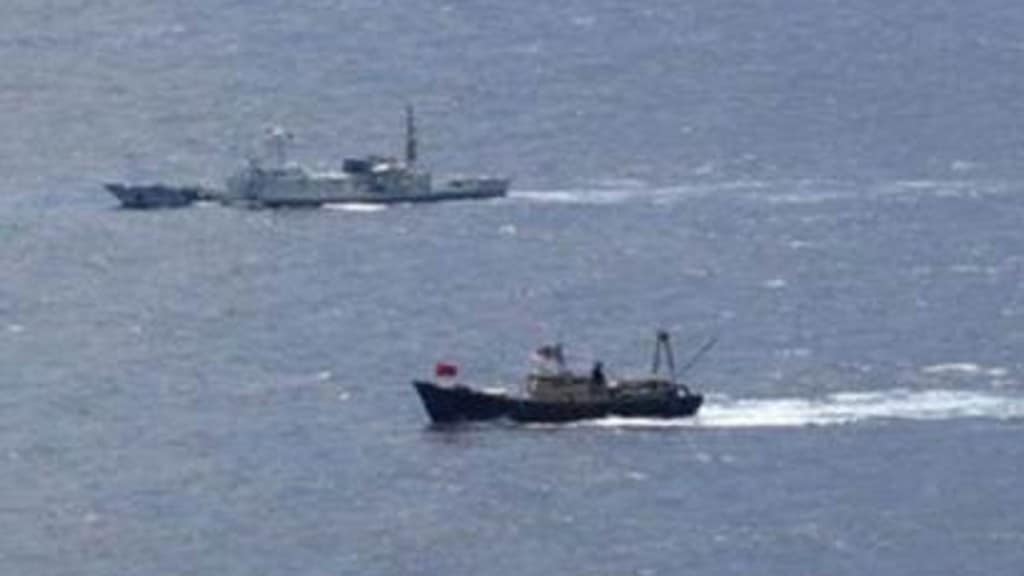On 17 June, a tense and violent confrontation erupted between the Chinese Coast Guard (CCG) and the Armed Forces of the Philippines (AFP) at the Ayungin Shoal. According to an AFP spokesperson, the incident began when the CCG obstructed the AFP’s humanitarian rotation and resupply operations to the BRP Sierra Madre (LS57). The Chinese used physical assaults, blinding strobe lights, bladed weapons, and blasting sirens in their forceful move.
Detailed Background
Despite overwhelming odds, Filipino troops valiantly defended their position. The CCG’s harassment escalated as they attached ropes to tow the AFP’s Rigid Hull Inflatable Boat (RHIB) while threatening to injure a Filipino soldier with a pickaxe. Continuous sirens disrupted communication and created chaos. CCG personnel swarmed the AFP’s RHIBs, wielding pointed weapons, hurling rocks, and slashing the boats to render them inoperable. Adding to the intimidation, a Chinese military aircraft circled overhead.
The confrontation culminated in a dramatic standoff where Filipino soldiers, using their bare hands, fended off Chinese personnel armed with swords, spears, and knives. General Romeo Brawner of the Philippines described the incident as an act of “piracy,” with the Chinese ramming Philippine boats, seizing weapons, and inflicting injuries, including the loss of a thumb by a Filipino soldier.
Tactics of Hybrid Warfare
This confrontation is not an isolated case but a component of a broader Chinese strategy to assert both overt and covert control over the South China Sea (SCS). By deploying maritime militias and dual-purpose vessels, Beijing exemplifies advanced grey zone tactics. The People’s Armed Forces Maritime Militia (PAFMM), which masquerades as civilian fishing boats, operates in conjunction with the People’s Liberation Army Navy (PLAN) and the Chinese Coast Guard (CCG), exerting Chinese influence in disputed waters.
China’s hybrid warfare techniques blur the distinction between civilian and military operations, complicating international efforts to respond effectively. The strategic use of these vessels in contested regions enables Beijing to retain plausible deniability while forcefully pushing its territorial claims. Incidents such as those at Ayungin Shoal underscore the PAFMM’s role in China’s stealthy yet assertive maneuvers.
Erosion of Influence
China’s relentless pursuit of hegemony in the SCS is beginning to backfire. According to western analysts the aggressive tactics employed by Beijing have sparked regional and international backlash, undermining its influence in the region. Commander Jonathan Dorsey, a United States Navy (USN) Fellow at the Stimson Center, in his article for the 9DashLine, writes neighbouring nations are increasingly drawing lines against China’s coercive tactics and uniting around a Free and Open Indo-Pacific (FOIP).
China’s excessive territorial claims, bolstered by the construction of artificial islands and the expansion of its naval fleet, have alienated its neighbours. The release of the new 10-dash line “standard map” further tightened its claims, but the tide is turning. Wary of Beijing’s bullying, countries in the region are finding common cause in pushing back against the revisionist power.
International and Regional Reactions
The Philippines’ President Ferdinand Marcos has warned that any Filipino death due to China’s actions would be seen as close to “an act of war.” Despite this, the Philippines seeks to prevent the situation from escalating into a full-scale conflict. The United States, a key ally, has condemned China’s actions and reiterated its commitment to the 1951 mutual defence treaty with the Philippines.
China’s coercive tactics have targeted not only its SCS neighbours but also countries perceived as impediments to its regional dominance. The United States Navy (USN), Japan Self-Defense Force, and Canada have faced risky encounters with Chinese vessels. Kelly Grieco, an expert on international relations, notes that the prospects for building a regional coalition to counter Chinese aggression are higher in the SCS than in the Taiwan Strait due to the direct impact on national security interests.
Pushing Back Against Beijing
Militarily outmatched, China’s SCS neighbours have developed successful counter-tactics through increased public information awareness, maritime security engagements, and additional defence investments. Countries like Vietnam and the Philippines have publicized Chinese vessels’ aggressive actions, drawing international scrutiny and support.
The Philippines has increased the number of drills and exercises with like-minded neighbours, while Vietnam has sought maritime cooperation on issues such as unplanned encounters and illegal fishing. Indonesia, the Philippines, and Malaysia have renewed coordinated patrols to combat piracy and terrorism. These efforts bolster confidence and resilience against Beijing’s bullying.
Strengthening Regional Security
Investment in maritime security is crucial for protecting civilian vessels, controlling resources within exclusive economic zones (EEZs), and upholding territorial claims. Japan is providing security assistance to the Philippines, Indonesia is negotiating new patrol vessel purchases with Italy, and the Philippines and Vietnam are expected to sign a memorandum of understanding on maritime cooperation.
The US-led efforts, including integrated deterrence and increased presence, are pivotal in fostering cooperative security in the SCS. The US Coast Guard’s (USCG) presence and capabilities are making inroads across the region, supporting maritime security practices and enhancing inter-regional collaboration.
China’s aggressive tactics in the SCS are backfiring as regional nations, supported by international allies, stand up to Beijing’s coercion. The latest clash with the Philippines underscores the high stakes and potential for further escalations. As Southeast Asian states discover methods to counter China’s grip on the SCS, Beijing may be compelled to reconsider its multi-front coercion campaign.
The mounting pressure from regional and international actors highlights the need for a rules-based order in the maritime domain. Persistent engagement, increased maritime security training, and enhanced inter-regional collaboration are vital to ensuring peace and stability in the South China Sea. The international community must remain vigilant and united to counter Beijing’s aggressive tactics and uphold the sovereignty of nations in the region.
